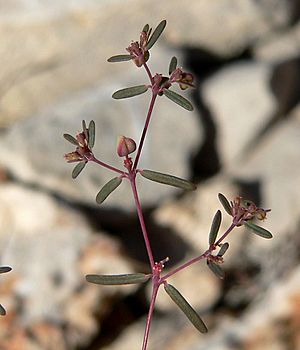Threadstem sandmat facts for kids
Quick facts for kids Threadstem sandmat |
|
|---|---|
 |
|
| Scientific classification | |
| Genus: |
Euphorbia
|
| Species: |
revoluta
|
| Synonyms | |
|
Chamaesyce revoluta |
|
The threadstem sandmat (scientific name: Euphorbia revoluta) is a small plant that grows every year. It is a type of euphorb plant. This plant is known for its thin stems, which look a bit like threads.
Contents
What is Threadstem Sandmat?
The threadstem sandmat is an annual herb. This means it grows from a seed, flowers, produces new seeds, and then dies all within one year. It is part of a very large group of plants called Euphorbia.
Where Does It Grow?
This plant is native to parts of Mexico and the southwestern United States. You can find it growing naturally from California all the way to the Rocky Mountains. It likes dry areas, including deserts like the Chihuahuan Desert and the Sonoran Desert.
What Does It Look Like?
The threadstem sandmat has thin stems that stand upright. These stems can be quite delicate. Its leaves are long and narrow, almost like tiny lines. Each leaf can grow up to about 2.6 centimeters long. The leaves usually grow in pairs along the stem.
Its Unique Flowers
The flowers of the threadstem sandmat are quite special. They are grouped together in a structure called a cyathium. A cyathium is a unique type of flower cluster found in Euphorbia plants. It looks like a single flower but is actually made of several tiny flowers.
Inside this cluster, there are rounded parts that produce nectar, a sweet liquid that attracts insects. There is one female flower and several male flowers. Sometimes, you might also see white parts that look like petals around the cluster. These white parts help to make the tiny flowers more noticeable to pollinators.
How Was It Used?
Long ago, the Navajo in North America found a use for this plant. They used the threadstem sandmat to make a type of skin lotion. This shows how different plants can be useful in traditional medicine and daily life.

